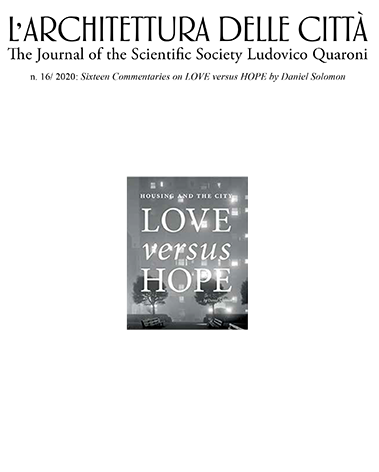Rowe and Solomon at the Crossroads of Architectural Education
Abstract
Dan Solomon’s book, Love versus Hope, comes at a particularly propitious time for architects and cities. With a world facing complex overlapping challenges of climate change, mass immigration, shortages of affordable housing and the forces of globalization, to name but a few, Solomon’s thesis about the power of place and the imperative for architects to understand how to shape it can be seen as an essential and necessary approach in promoting a more sustainable, just and equitable society. In Solomon’s case, that shaping occurs through the design of dignified and equitable residential projects, based on context yet also recognizing that a simple-minded return to techniques of the past probably will not suffice.
Appearing (or lurking?) throughout Solomon’s text is the figure of Colin Rowe, author with Fred Koetter of Collage City, arguably the first thesis to articulate the problems of “mod arch” as an approach to the city and to offer insights about how the problems of “light, air and sunshine” might be accommodated in forms other than the Radiant City of Le Corbusier or the Zeilenbau blocks of the Bauhaus. Like Rowe, Solomon is a “mod arch graduate”, educated in the basics of modernism as a “true believer” and over the course of his career, began to see cracks in the theories that were the basis of his education. Like Rowe and Koetter, Solomon sees the power and grace of much of modernisms notable achievements yet unlike Rowe and Koetter, his insights and critique are largely based on insights gained through practice and observation, rather than through questioning the fundamental intellectual assumptions of modernism.
Solomon’s conversational style of writing is both engaging and perhaps a tad misleading. Although accessible in a way many current critics are not, he delivers a critique of both the Congress for the New Urbanism as well as the orthodoxy of education in architecture at many of the (thought to be by many) leading schools of design. Solomon makes a great effort to identify workaday neighborhoods in Rome, often overlooked by the academic elite, that can serve a models for the making of the modern city. So, with the virtues of those models in mind and the current multiple crises of society compounding everyday, and recognizing that the poles of New Urbanism and the GSD might not be enough, what would an architectural education look like, as proposed by Rowe and Solomon? What sorts of changes would need to be made and how would that be taught?


